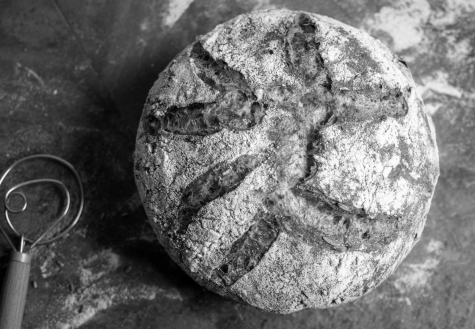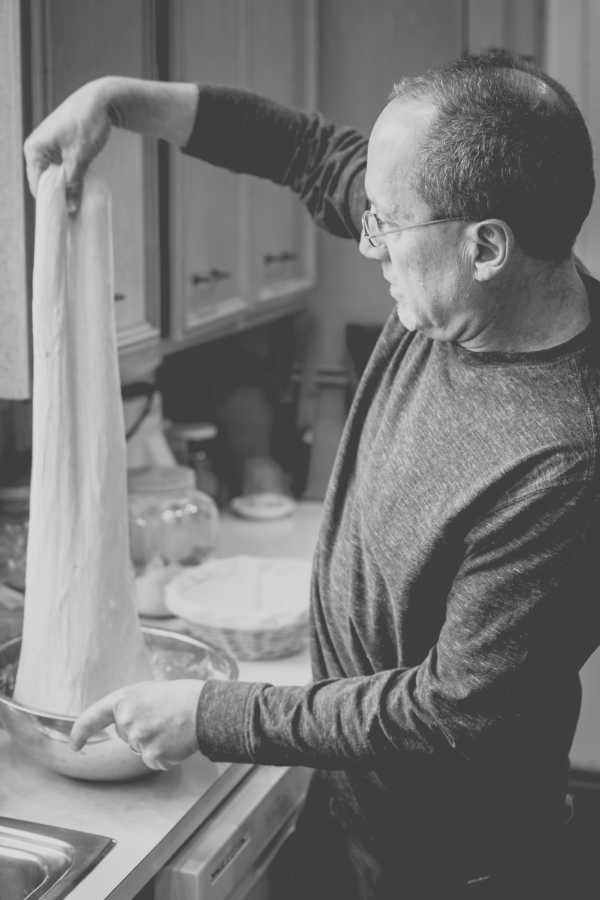Baking sourdough bread and fostering connection
Eric Pallant releases ‘Sourdough Culture,’ traces starter to 1893
Pallant stretches the dough as he prepares sourdough bread in his home. Photo courtesy of John Mangine.
Lizzy Russo, ’22, walked into the Carr Hall kitchen on a particularly dreary Wednesday afternoon. Unlike the usual faculty and students who regularly utilize the kitchen, Russo was not there to heat up lunch — rather they were there to pick up sourdough starter from Eric Pallant, Christine Scott Nelson ’73 Endowed Professor of Environmental Science and Sustainability.
“Because we just fed this (starter), I’m going to suggest you leave it out until tonight,” Pallant said to Russo. “It will grow and expand. Put it in the fridge until you’re ready to use it.”
Pallant, a self-defined “serious amateur baker,” recently released his first book, “Sourdough Culture: A History of Bread Making from Ancient to Modern Bakers.” Pallant has received national attention since the release, including a spot on Science Friday from National Public Radio and a feature by CNN. Pallant was baking the recipe that was featured on CNN with Rachael Pieto, ’23, a student who is helping Pallant manage his website which tracks where he sends starters all over the world.
Unlike regular bread, which uses yeast as a leavening agent to make the bread rise, sourdough bread is leavened with a starter made from flour and water. The natural fermentation of the mixture allows the bread to rise and creates its sour flavor.
“The paradox of a sourdough starter,” Pallant writes in the introduction of “Sourdough Culture,” “is that while each cell responsible for raising a loaf of bread is but a few hours old when it is cooked, the ability of people to harness the microbial power of yeast and bacteria to leaven is (as) old as civilization itself.”
Pallant received his first sourdough starter in 1988 when he joined the newly-formed environmental science department at Allegheny College. It was gifted to him by Quimby Mamula, the wife of the director of financial aid at the time. After experimenting with sourdough recipes for nearly a decade, Pallant decided he wanted to trace the starter to its origin.
Through his research, Pallant traced his first-ever starter to the Cripple Creek Gold Rush of 1893.
While Pallant’s book traces sourdough from Ancient Babylon to Ancient Egypt, Ancient Rome and forward, it also explores what bread signifies religiously, spiritually and culturally across time and continents.
“Globally, until recently, bread was really unique to an area and a culture,” Pallant said. “Breads of North Africa are made in tajines and they’re made in open flames and they’re flatbreads where you throw them against the hot stove. In (the Middle East), there’s a meaning there (to the breads). They grew up with it and they recognize this in their own culture. It’s inseparable. There’s nothing that will take someone back home to their country more quickly than an authentic freshly made bread of their home country.”
Pallant said that bread is not as embedded in American culture as elsewhere in the world, largely due to a desire for convenience and on-the-go meals.

“We’re a country that’s in a hurry,” Pallant said. “Foods (are) premade and prepared by somebody else. I think it says something about American culture that we’re more interested in efficiency than flavor.”
When people were forced to shut in due to the pandemic last year, many found unique ways to pass the time. Some tried home workouts, family walks or crafting. The sudden surge in at-home activities caused nationwide shortages of things like dumbbells, gaming headsets and yeast.
Yeast, of course, is a staple of breadmaking. But since yeast was largely unavailable due to increased demand, many people turned to an alternative — sourdough.
There’s something in us that relates to the smell of freshly baked bread. There’s not a human on the planet that doesn’t start to salivate as that smell of fresh baked bread comes out of the oven. There’s something about our survival as a species that’s tied to recognizing that this was important for us since the beginning of time.
— Eric Pallant
“Why, of all the things you could do, would sourdough bread be the thing you would take up during the pandemic?” Pallant said. “There’s something in us that relates to the smell of freshly baked bread. There’s not a human on the planet that doesn’t start to salivate as that smell of fresh baked bread comes out of the oven. There’s something about our survival as a species that’s tied to recognizing that this was important for us since the beginning of time.”
“Sourdough Culture” is full of Pallant’s favorite recipes — and the book reads like one. Pallant writes as though he is in the kitchen with readers, teaching how to bake bread while thoroughly explaining the science and history behind it for amateur bakers, scientists and geographers alike.
Pallant writes not primarily as a scientist who is researching the chemical properties and geographic movement of bread, but as an avid lover of baking and the connections it fosters among families, friends and communities.
“In a COVID-19 world of sensory deprivation,” Pallant writes in the “Final Proof” chapter of the book, “no hugging, no kissing, where even a gentle hand on a shoulder signified that you were too close — perhaps dough acted as an imperfect replacement. A baker touched dough, kneading invisible strands of gluten until the dough felt as soft and supple as human skin.”
“I don’t think it’s unique to me to want to make any food and want to share it,” Pallant said. “The joy of making food is partly the making and partly the consuming, but much more joy comes from sharing it with people you care about. That, to me, is irresistible.”
“Sourdough Culture” is published by Agate Publishing and is now available at major retailers, including Amazon and Barnes and Noble. To learn more about Pallant, sourdough bread and to find recipes or purchase a starter, visit EricPallant.com.
Sami Mirza contributed to this report.

Ethan Woodfill is a senior from Pittsburgh, Pennsylvania. He is an Environmental Science & Sustainability and Political Science double major with an...












